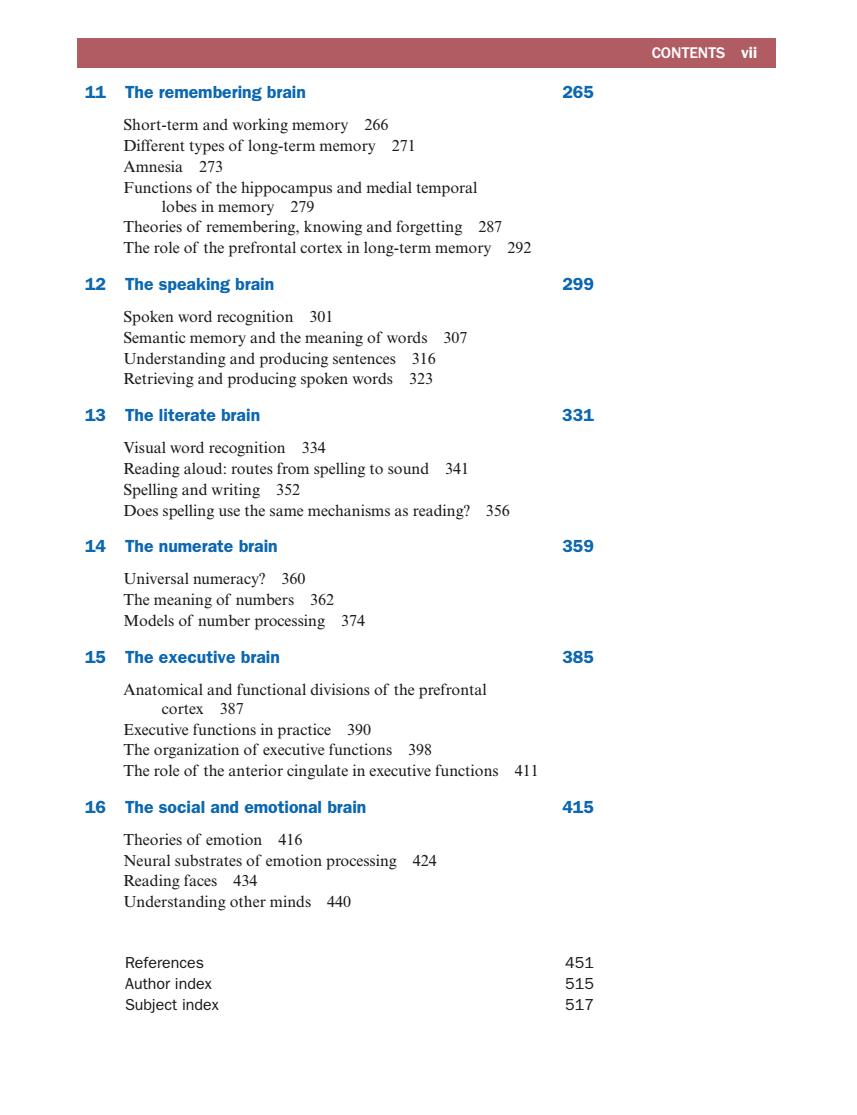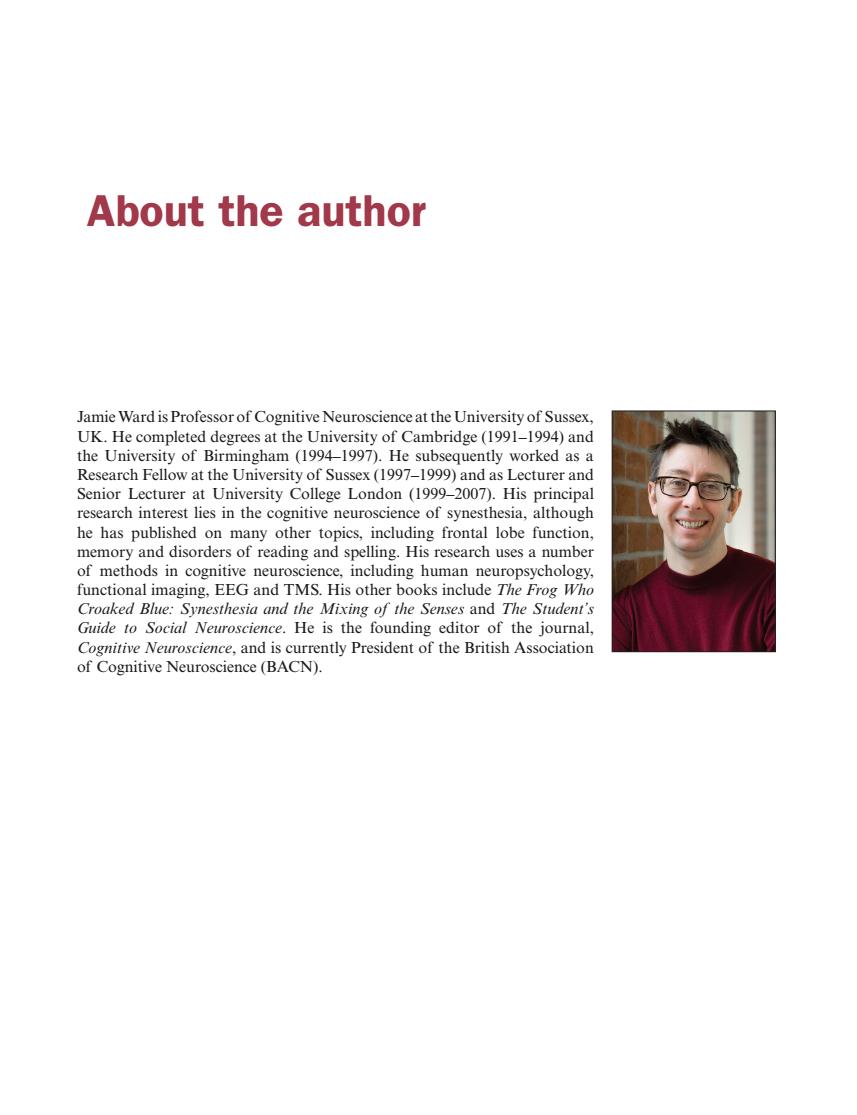
vi CONTENTS 5 The lesioned brain and stimulated brain 87 Dissociations and associations in neuropsychology 90 Single-case studies in cognitive neuropsychology 93 Group studies and lesion-deficit analysis in neuropsychology 97 Animal models in neuropsychology 100 Transcranial magnetic stimulation (TMS)102 Transcranial electrical stimulation (tES)110 6 The developing brain 115 Structural development of the brain 118 Functional development of the brain 122 Nature and nurture of individual differences 129 7 The seeing brain 143 From eye to brain 144 Cortical blindness and“blindsight”l4g Functional specialization of the visual cortex beyond VI 152 Recognizing objects 156 Recognizing faces 164 Vision imagined 171 8 The hearing brain 175 The nature of sound 177 From ear to brain 178 Basic processing of auditory information 181 Music perception 186 Voice r perception 191 Speech perception 193 9 The attending brain 203 Spatial and non-spatial attentional process 204 The role of the frontoparietal network in attention 208 Theories of attention 217 Neglect as a disorder of spatial attention and awareness 224 10 The acting brain 233 0phmeonmaaa2 A basic cognitive framework for movement and action Ownership and awareness of actions 242 Action comprehension and imitation 246 Acting on objects 249 Fronto-striatal and cerebellar networks in action 258
vi CONTENTS 5 The lesioned brain and stimulated brain 87 Dissociations and associations in neuropsychology 90 Single-case studies in cognitive neuropsychology 93 Group studies and lesion-deficit analysis in neuropsychology 97 Animal models in neuropsychology 100 Transcranial magnetic stimulation (TMS) 102 Transcranial electrical stimulation (tES) 110 6 The developing brain 115 Structural development of the brain 118 Functional development of the brain 122 Nature and nurture of individual differences 129 7 The seeing brain 143 From eye to brain 144 Cortical blindness and “blindsight” 149 Functional specialization of the visual cortex beyond V1 152 Recognizing objects 156 Recognizing faces 164 Vision imagined 171 8 The hearing brain 175 The nature of sound 177 From ear to brain 178 Basic processing of auditory information 181 Music perception 186 Voice perception 191 Speech perception 193 9 The attending brain 203 Spatial and non-spatial attentional process 204 The role of the frontoparietal network in attention 208 Theories of attention 217 Neglect as a disorder of spatial attention and awareness 224 10 The acting brain 233 A basic cognitive framework for movement and action 234 The role of the frontal lobes in movement and action 235 Ownership and awareness of actions 242 Action comprehension and imitation 246 Acting on objects 249 Fronto-striatal and cerebellar networks in action 258

CONTENTS vii 11 The remembering brain 265 Short-term and working memory 266 Different types of long-term memory 271 Amnesia 273 Functions of the hippocampus and medial temporal lobes in memory 279 Theories of remembering,knowing and forgetting 287 The role of the prefrontal cortex in long-term memory 292 12 The speaking brain 299 Spoken word recognition 301 Semantic me emory and the meaning of words 307 Understanding and producing sentences 316 Retrieving and producing spoken words 323 13 The literate brain 331 Visual word recognition 334 Reading aloud:routes from spelling to sound 341 Spellinnd riting 352 Does spelling use the same mechanisms as reading?356 14 The numerate brain 359 Universal numeracy?360 The meaning of numbers 362 Models of number processing 374 15 The executive brain 385 Aamorangncioaliiosotepmiona cortex Executive functions in practice 390 The organization of executive functions 398 The role of the anterior cingulate in executive functions 411 16 The social and emotional brain 415 Rahehs2gmoionpmig4g Theories of emotion 416 Neural sut Understanding other minds 440 References Author index Subject index
CONTENTS vii 11 The remembering brain 265 Short-term and working memory 266 Different types of long-term memory 271 Amnesia 273 Functions of the hippocampus and medial temporal lobes in memory 279 Theories of remembering, knowing and forgetting 287 The role of the prefrontal cortex in long-term memory 292 12 The speaking brain 299 Spoken word recognition 301 Semantic memory and the meaning of words 307 Understanding and producing sentences 316 Retrieving and producing spoken words 323 13 The literate brain 331 Visual word recognition 334 Reading aloud: routes from spelling to sound 341 Spelling and writing 352 Does spelling use the same mechanisms as reading? 356 14 The numerate brain 359 Universal numeracy? 360 The meaning of numbers 362 Models of number processing 374 15 The executive brain 385 Anatomical and functional divisions of the prefrontal cortex 387 Executive functions in practice 390 The organization of executive functions 398 The role of the anterior cingulate in executive functions 411 16 The social and emotional brain 415 Theories of emotion 416 Neural substrates of emotion processing 424 Reading faces 434 Understanding other minds 440 References 451 Author index 515 Subject index 517

Taylor Francis Taylor Francis Group ttp://taylorandfrancis.com

About the author Jamie Ward is Professor of Cognitive Neuroscience at the University of Sussex UK.He completed degrees at the University of Cambridge(1991-1994)and the University of Birmingham(1994-1997).He subsequently worked as a Research Fellow at the University of Sussex(1997-1999)and as Lecturer and Senior Lecturer at University College London (1999-2007).His principal research interest lies in the cognitive neuroscience of synesthesia,although he has published on many other topics,including frontal lobe function, memory and disorders of reading and spelling.His research uses a number of methods in cognitive neuroscience,including human neuropsychology. functional imaging,EEG and TMS.His other books include The Frog Who Croaked Blue:Synesthesia and the Mixing of the Senses and The Student's Guide to Social Neuroscience.He is the founding editor of the journal, Cognitive Neuroscience,and is currently President of the British Association of Cognitive Neuroscience(BACN)
About the author Jamie Ward is Professor of Cognitive Neuroscience at the University of Sussex, UK. He completed degrees at the University of Cambridge (1991–1994) and the University of Birmingham (1994–1997). He subsequently worked as a Research Fellow at the University of Sussex (1997–1999) and as Lecturer and Senior Lecturer at University College London (1999–2007). His principal research interest lies in the cognitive neuroscience of synesthesia, although he has published on many other topics, including frontal lobe function, memory and disorders of reading and spelling. His research uses a number of methods in cognitive neuroscience, including human neuropsychology, functional imaging, EEG and TMS. His other books include The Frog Who Croaked Blue: Synesthesia and the Mixing of the Senses and The Student’s Guide to Social Neuroscience. He is the founding editor of the journal, Cognitive Neuroscience, and is currently President of the British Association of Cognitive Neuroscience (BACN)

Taylor Francis Taylor Francis Group ttp://taylorandfrancis.com